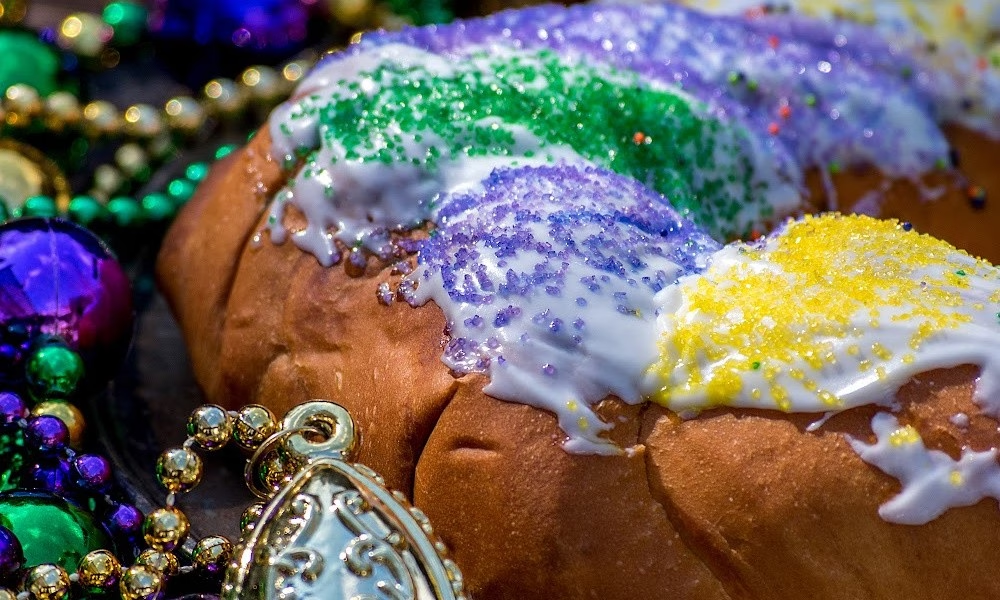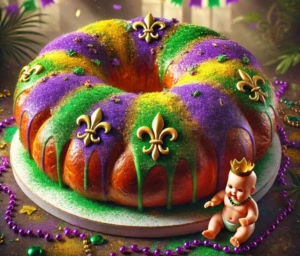
The King Cake is more than just a dessert—it’s a beloved symbol of community, celebration, and cultural heritage. Rooted in centuries-old traditions, King Cakes are particularly popular during the Mardi Gras season, with vibrant versions gracing bakeries and dining tables across the Gulf Coast, including Texas. Let’s dive into the history, tradition, and regional variations of this iconic treat.
A Brief History of King Cakes
The tradition of King Cakes dates back to medieval France and Spain, where the “Galette des Rois” or “Rosca de Reyes” was served during the Feast of the Epiphany, also known as “King’s Day.” This Christian celebration, held on January 6, commemorates the arrival of the three wise men (or kings) who visited the baby Jesus. The cake was seen as a way to honor this significant day, and it typically featured a hidden charm or bean symbolizing luck and prosperity.
When French and Spanish settlers arrived in the Americas, they brought this custom with them, particularly to Louisiana. By the 19th century, King Cakes had become an essential part of Mardi Gras festivities in New Orleans, evolving into the brightly colored, festive cakes we know today. The tradition spread beyond Louisiana to neighboring states like Texas, where coastal and urban communities have embraced it with their own twists.
What Makes a King Cake?
A traditional King Cake is a ring-shaped or oval pastry made from a rich, brioche-style dough flavored with cinnamon. It is typically adorned with purple, green, and gold icing or sugar—colors that represent justice, faith, and power, respectively.  Inside the cake, a small figurine, often a plastic baby, is hidden. Whoever finds the baby in their slice is said to receive good fortune and is often tasked with hosting the next King Cake party.
Inside the cake, a small figurine, often a plastic baby, is hidden. Whoever finds the baby in their slice is said to receive good fortune and is often tasked with hosting the next King Cake party.
Over time, bakeries have experimented with fillings, adding flavors like cream cheese, pecan praline, and fruit preserves. Modern versions of King Cakes range from the simple and classic to decadent varieties topped with nuts, drizzles, and even bacon crumbles.
King Cake Seasonality
King Cake season officially begins on January 6, marking the Feast of the Epiphany, and lasts through Mardi Gras, which culminates on Fat Tuesday, the day before Lent begins. While it is tempting to enjoy these cakes year-round, many bakeries adhere strictly to the traditional season to preserve the sense of anticipation and excitement.
For many families, the arrival of King Cake season signals the start of celebrations, parades, and gatherings that make Mardi Gras so special. Sharing a King Cake is as much about the community and tradition as it is about the delicious flavors.
Regionality and Popularity
While New Orleans is often considered the heart of the King Cake tradition, Texas has carved out its own space in the celebration. Cities like Houston, Austin, and Galveston boast bakeries that offer their own spins on the King Cake, sometimes infusing Texas flavors into the classic recipe. For example, Texas bakeries might offer King Cakes with pecan pie filling, jalapeño-infused cream cheese, or even a nod to Tex-Mex with dulce de leche or cinnamon-spiced chocolate.
In Galveston, which hosts one of the largest Mardi Gras celebrations outside of Louisiana, King Cakes are a centerpiece at parties and parades. Similarly, King Cakes in the Bolivar Peninsula and Crystal Beach area often sell out as locals and visitors indulge in the festive season.
Texas Variations of King Cakes
Texans are known for putting a creative spin on classic traditions, and King Cakes are no exception. Some notable Texas variations include:
- Kolache-Inspired King Cakes: Merging two beloved pastries, these versions feature dough reminiscent of Czech kolaches, filled with sweet fruit preserves or cream cheese.
- Savory King Cakes: Some bakeries in Texas offer savory versions filled with boudin sausage or queso, making them a delicious appetizer for Mardi Gras gatherings.
- BBQ-Inspired Cakes: True to Texas’s love for BBQ, a few specialty shops have even experimented with smoky, pulled pork-stuffed King Cakes for adventurous eaters.
Interesting Facts About King Cakes
- The Baby Tradition: The plastic baby used today became popular in the mid-20th century. Originally, a porcelain or gold bean was often used.
- Record-Breaking Cakes: Some Mardi Gras celebrations have featured King Cakes that span hundreds of feet to feed large crowds.
- Symbolism of the Shape: The round or oval shape is meant to symbolize unity and the journey of the wise men.
Conclusion
The King Cake is a treasured part of Mardi Gras culture, representing joy, tradition, and indulgence. Whether you prefer a classic cinnamon-flavored cake or an innovative Texas twist, the King Cake remains a delicious way to honor the season. For Gulf Coast communities, especially those in Texas, it’s more than just a dessert—it’s a delicious reminder of the joy that comes from gathering with friends and family to celebrate life’s sweetest moments.




